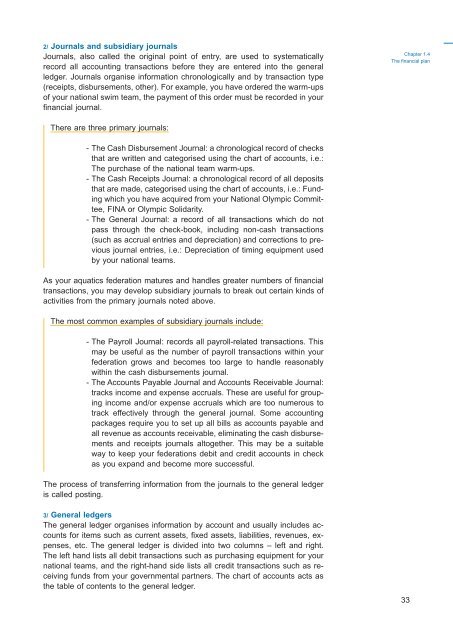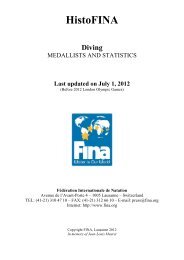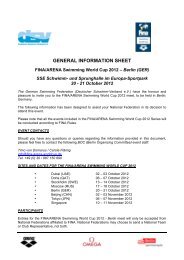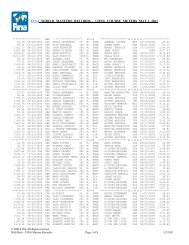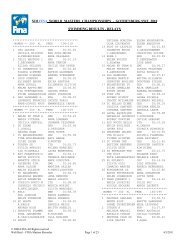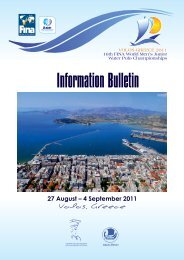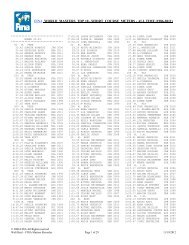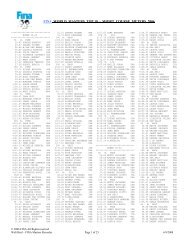- Page 3: Building New Ways for Success in Aq
- Page 7 and 8: Table of contents FINA National Fed
- Page 11: Creating your plan Chapter 1.1 Deve
- Page 14 and 15: Chapter 1.1 Developing mission, vis
- Page 16 and 17: Chapter 1.1 Developing mission, vis
- Page 18 and 19: Chapter 1.1 Developing mission, vis
- Page 20 and 21: Chapter 1.2 A strategic plan for a
- Page 22 and 23: Chapter 1.2 A strategic plan for a
- Page 24 and 25: Chapter 1.2 A strategic plan for a
- Page 27 and 28: Chapter 1.3 New ideas on strategic
- Page 29 and 30: The basic idea is that most federat
- Page 31: Chapter 1.4 The financial plan Bene
- Page 35 and 36: Financial Statements Financial stat
- Page 37 and 38: Financial controls There are certai
- Page 39 and 40: Chapter 1.5 Winning story Swimming
- Page 41 and 42: How has developing a mission and vi
- Page 45: Securing your structure Chapter 2.1
- Page 48 and 49: Chapter 2.1 Structure: making the p
- Page 50 and 51: Chapter 2.1 Structure: making the p
- Page 52 and 53: Chapter 2.2 Governance of a Nationa
- Page 54 and 55: Chapter 2.2 Governance of a Nationa
- Page 57 and 58: Chapter 2.3 National Federation str
- Page 59 and 60: In a divisional federation, the foc
- Page 61 and 62: There are advantages of a physical
- Page 63 and 64: Swimming South Africa Organisationa
- Page 65: 4/ Swimmers’ Delegate FS register
- Page 68 and 69: Chapter 2.4 Measurement and Evaluat
- Page 71 and 72: Chapter 2.5 Winning story Danish Sw
- Page 73: What challenges have you faced in i
- Page 79 and 80: Chapter 3.1 Creating a National Fed
- Page 81 and 82: Sports federations that have been m
- Page 83:
4/ Determine where your competitors
- Page 86 and 87:
Chapter 3.2 Promotional activities
- Page 88 and 89:
Chapter 3.2 Promotional activities
- Page 91 and 92:
Chapter 3.3 Media relations and ope
- Page 93 and 94:
National team activities The media
- Page 95 and 96:
Media release/press release A media
- Page 97 and 98:
Press conference mechanics Press co
- Page 99 and 100:
FINA President Dr. Julio C. Maglion
- Page 101 and 102:
Chapter 3.4 Digital media and socia
- Page 103 and 104:
Understanding the language of digit
- Page 105:
Useful tips Digital media can sprea
- Page 108 and 109:
Chapter 3.5 Winning story Brazilian
- Page 113:
Choosing your people Chapter 4.1 Mo
- Page 116 and 117:
Chapter 4.1 Motivating for involvem
- Page 118 and 119:
Chapter 4.1 Motivating for involvem
- Page 120 and 121:
Chapter 4.2 Working with volunteers
- Page 122 and 123:
Chapter 4.2 Working with volunteers
- Page 124 and 125:
Chapter 4.3 Creating a learning org
- Page 126 and 127:
Chapter 4.3 Creating a learning org
- Page 128 and 129:
Chapter 4.4 Rules, policies and eth
- Page 130 and 131:
Chapter 4.4 Rules, policies and eth
- Page 132 and 133:
Chapter 4.5 Winning story Italian S
- Page 137:
Increasing your income Chapter 5.1
- Page 140 and 141:
Chapter 5.1 Growing the membership
- Page 142 and 143:
Chapter 5.1 Growing the membership
- Page 144 and 145:
Chapter 5.2 Sponsorship 144 Introdu
- Page 146 and 147:
Chapter 5.2 Sponsorship 146 Therefo
- Page 149 and 150:
Chapter 5.3 Working with public sec
- Page 151 and 152:
The public sector today is interest
- Page 153 and 154:
How are sports federations adjustin
- Page 155 and 156:
ferent and be open to new ways of o
- Page 157 and 158:
Chapter 5.4 Alternative funding opp
- Page 159:
5/ Organisation When raising money,
- Page 162 and 163:
Chapter 5.5 Winning story USA Swimm
- Page 167:
Supporting your sport Chapter 6.1 S
- Page 170 and 171:
Chapter 6.1 Supporting athletes 170
- Page 173 and 174:
Chapter 6.2 Supporting coaches Bene
- Page 175:
Coaches Code of Conduct should at l
- Page 178 and 179:
Chapter 6.3 Supporting officials 17
- Page 181 and 182:
Chapter 6.4 Competition and events
- Page 183 and 184:
country is the perfect platform to
- Page 185:
Annex D FINA World Championships ti
- Page 188 and 189:
Chapter 6.5 Winning story Amateur S
- Page 193:
Improving your skills Chapter 7.1 T
- Page 196 and 197:
Chapter 7.1 The importance of conti
- Page 198 and 199:
Chapter 7.1 The importance of conti
- Page 200 and 201:
Chapter 7.1 The importance of conti
- Page 202 and 203:
Chapter 7.1 The importance of conti
- Page 204 and 205:
Chapter 7.2 Presentation skills 204
- Page 206 and 207:
Chapter 7.2 Presentation skills 206
- Page 208 and 209:
Chapter 7.2 Presentation skills 208
- Page 210 and 211:
Chapter 7.2 Presentation skills 210
- Page 212 and 213:
Chapter 7.2 Presentation skills 212
- Page 215 and 216:
Chapter 7.3 Selling and influencing
- Page 217 and 218:
How can you market effectively to e
- Page 219 and 220:
prospective clients with constant c
- Page 221:
These hints include: 1/ Talk about
- Page 224 and 225:
Chapter 7.4 Negotiation skills 224
- Page 226 and 227:
Chapter 7.4 Negotiation skills 226
- Page 228 and 229:
Chapter 7.4 Negotiation skills 228
- Page 231 and 232:
Chapter 7.5 Winning story Papua New
- Page 233 and 234:
Each year we also produce a yearboo
- Page 235 and 236:
We are able to meet deadlines for r
- Page 239:
Enhancing your development programm
- Page 242 and 243:
Chapter 8.1 FINA National Federatio
- Page 244 and 245:
Chapter 8.1 FINA National Federatio
- Page 246 and 247:
Chapter 8.1 FINA National Federatio
- Page 248 and 249:
Chapter 8.1 FINA National Federatio
- Page 250 and 251:
FINA NATIONAL FEDERATIONS DEVELOPME
- Page 252 and 253:
FINA NATIONAL FEDERATIONS DEVELOPME
- Page 254 and 255:
Course Organisation FINA NATIONAL F
- Page 256 and 257:
Please complete the bank details of
- Page 258 and 259:
Chapter 8.1 FINA National Federatio
- Page 260 and 261:
FINA NATIONAL FEDERATIONS DEVELOPME
- Page 262 and 263:
FINA NATIONAL FEDERATIONS DEVELOPME
- Page 264 and 265:
FINA NATIONAL FEDERATIONS DEVELOPME
- Page 266 and 267:
Please complete the bank details of
- Page 268 and 269:
Chapter 8.1 FINA National Federatio
- Page 270 and 271:
Chapter 8.1 FINA National Federatio
- Page 272 and 273:
The National Federation of: Partici
- Page 274 and 275:
Name of National Federation: FINA N
- Page 276 and 277:
Please complete the bank details of
- Page 278 and 279:
Chapter 8.1 FINA National Federatio
- Page 280 and 281:
FINA NATIONAL FEDERATIONS DEVELOPME
- Page 282 and 283:
FINA NATIONAL FEDERATIONS DEVELOPME
- Page 284 and 285:
Chapter 8.1 FINA National Federatio
- Page 286 and 287:
The National Federation of: FINA NA
- Page 288 and 289:
National Federation of : Team: FINA
- Page 290 and 291:
FINA NATIONAL FEDERATIONS DEVELOPME
- Page 292 and 293:
Chapter 8.1 FINA National Federatio
- Page 294 and 295:
Chapter 8.1 FINA National Federatio
- Page 296 and 297:
Chapter 8.1 FINA National Federatio
- Page 298 and 299:
Chapter 8.1 FINA National Federatio
- Page 300 and 301:
The National Federation of: FINA NA
- Page 302 and 303:
FINA NATIONAL FEDERATIONS DEVELOPME
- Page 304 and 305:
Course evaluation FINA NATIONAL FED
- Page 306 and 307:
Financial form FINA NATIONAL FEDERA
- Page 308 and 309:
FINA DEVELOPMENT PROGRAMME 2010 PRI
- Page 310 and 311:
Chapter 8.1 FINA National Federatio
- Page 312 and 313:
Chapter 8.1 FINA National Federatio
- Page 314 and 315:
FINA NATIONAL FEDERATIONS DEVELOPME
- Page 316 and 317:
Course Organisation FINA NATIONAL F
- Page 318 and 319:
Financial form FINA NATIONAL FEDERA
- Page 320 and 321:
Chapter 8.1 FINA National Federatio
- Page 322 and 323:
The National Federation of: Partici
- Page 324 and 325:
Attachments FINA NATIONAL FEDERATIO
- Page 326 and 327:
Course evaluation FINA NATIONAL FED
- Page 328 and 329:
Please complete the bank details of
- Page 330 and 331:
Chapter 8.1 FINA National Federatio
- Page 332 and 333:
Chapter 8.1 FINA National Federatio
- Page 334 and 335:
The National Federation of: FINA CL
- Page 336 and 337:
FINA CLINICS FOR OFFICIALS (JUDGES
- Page 338 and 339:
Course evaluation FINA CLINICS FOR
- Page 340 and 341:
Financial form FINA CLINICS FOR OFF
- Page 342 and 343:
FINA DEVELOPMENT PROGRAMME 2010 PRI
- Page 344 and 345:
Chapter 8.1 FINA National Federatio
- Page 346 and 347:
National Federation: School Details
- Page 348 and 349:
National Federation: FINA SCHOOLS F
- Page 350 and 351:
National Federation: FINA SCHOOLS F
- Page 352 and 353:
I. Expenses covered by FINA Financi
- Page 355 and 356:
Chapter 8.2 Olympic Solidarity Prog
- Page 357 and 358:
3/ Olympic Games subsidies, which c
- Page 359 and 360:
The choice of the high level traini
- Page 361 and 362:
The programmes proposed by the NOCs
- Page 363 and 364:
quently, Olympic Solidarity wishes
- Page 365 and 366:
2/ Sport-Specific Training (option
- Page 367:
For f urther information regarding
- Page 370 and 371:
Chapter 8.3 FINA Anti-doping Progra
- Page 372 and 373:
Chapter 8.3 FINA Anti-doping Progra
- Page 374 and 375:
Chapter 8.4 National partnerships 3
- Page 376 and 377:
Chapter 8.4 National partnerships 3
- Page 379 and 380:
Chapter 8.5 Winning story Swimming/
- Page 381 and 382:
Personal Notes 381
- Page 383 and 384:
Personal Notes 383


